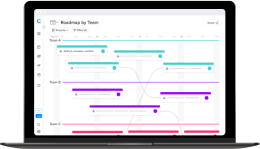Home > Blog > How to Prioritize Your OKRs
How to Prioritize Your OKRs

As a product professional, you know the dilemma well: You always have more ideas for your product than you have the resources, budget, or time to execute on those ideas.
This challenge extends directly to strategic goal setting, requiring you to master effective OKR prioritization. If you want to determine how to prioritize strategy with OKRs, the established rules you use for managing your product apply directly to successful business prioritization with OKRs.
Prioritizing OKRs Is Similar to Prioritizing Work on the Product Itself
The same challenge, unfortunately, holds true for the broader business objectives you have in mind for your product – the marketing goals, sales goals, media goals, etc. No product team ever has enough resources to simultaneously achieve every business objective it thinks up. Strategic marketing management, much like product management, relies on careful prioritization to succeed.
So how do you determine which business goals to pursue for your product’s success (and which ones to let go)? The same way you make decisions about your product itself: prioritization.
When you need to narrow your idea-filled product backlog to a handful of epics, features, or other items that will deliver the greatest strategic value for your customer, you prioritize. There are plenty of useful product prioritization frameworks out there to help you determine which product initiatives to pursue (or at least to pursue before others).
And when it comes to setting market goals for your product, the most effective prioritization approach we’ve ever seen is the Objectives and Key Results (OKR) framework.

Setting Strategic Goal Prioritization with the OKR Strategy
The OKR strategy comes from venture capitalist John Doerr, who introduced the concept to a fledging little company called Google, where he was one of the original investors and advisors. Doerr later wrote about his OKR framework in his book Measure What Matters. And if you’re serious about steering your product to success, we believe that reading this book is one of the best ways to invest five or six hours of your spare time.
The foundation of the OKR model is that both the Objective and the Key Results need to be specific. As Doerr explains in his book – and as he told those early Googlers 30 years ago – if you can’t put a number to it, you can’t call it a Key Result.
This forces your team to limit your focus only to those objectives you can quantifiably and definitively measure. And as Doerr argues, that’s an invaluable limiting mechanism, because it forces your team to choose strategically advantageous goals and then put their energy into achieving them. As you know, what gets measured… gets done.
The Three Essential Rules for Writing Great OKRs
To ensure your Objectives and Key Results drive effective business prioritization with OKRs, they must adhere to three essential rules. These rules are demonstrated in the following examples for marketing your new product:
-
They’re Quantifiable
The Key Result must include hard numbers and metrics so success is objectively measurable. (Either you achieve the desired numbers, or you don’t).
-
They have Clearly Defined Time Windows
A clear deadline must be set for the Key Result. (Either you achieve the outcomes within the established timeframe, or you don’t).
-
They’re Realistic
Accountability ensures you set achievable goals. (When everyone will be monitoring your progress, you won’t set goals that are known to be unachievable.)
Now, let’s look at a couple of hypothetical OKRs for marketing your new product:
OBJECTIVE:
Increase trial usage.
KEY RESULT:
Reach 1,000 free-trial downloads per month (within the next four months)
OBJECTIVE:
Increase Sales-Qualified Leads (SQLs).
KEY RESULT:
Improve the conversion rate from Marketing-Qualified Leads (MQLs) to SQLs from 1% to 2.5% (within the next three months).
In both of these examples, the desired outcomes have a few important characteristics that make them a valuable way to measure progress:
- They’re quantifiable.
(Either you achieve the desired numbers, or you don’t).
- They have clearly defined time windows.
(Either you achieve the outcomes within the established timeframes, or you don’t). - They’re realistic.
(When everyone will be monitoring your progress, you won’t set unachievable goals.)
While these examples show you how to write effective goals, a typical product team will generate many more great OKRs than it can possibly handle. The next step is to learn how to prioritize this entire set of objectives to ensure your team focuses on what drives the greatest strategic value.
How to Decide Which OKRs to Prioritize Over the Others
Back to our original question: How do you choose which OKRs to pursue?
As we noted in the intro, you’ll want to take a similar approach when weighing the competing OKRs to the approach you take when narrowing your product backlog to just a few strategically beneficial epics, stories, or other items to work on first.
Because you’ll never have enough resources to pursue every OKR on your wish list at the same time, you’ll need to review them all against each other using key strategic criteria. It’ll be a balancing act where your team weighs, for example, each OKR’s potential:
- Impact on the product’s success
- Level of effort or difficulty
- Cost
Contribution to your company’s broader business objectives
Assessing Potential Risk and Pitfalls
Setting objectives is easy; challenging them is the hard part. Let’s analyze the potential benefits and drawbacks of a seemingly simple objective to spot hidden risks. This critical analysis ensures your final prioritization truly supports your core business goals, so let’s examine the first hypothetical OKR’s benefits and drawbacks.
OBJECTIVE:
Increase trial usage.
KEY RESULT:
Reach 1,000 free-trial downloads per month (within the next four months).
At first glance, this seems like a great OKR to pursue. And it might be. But let’s take a closer look. (This is the type of strategic analysis you’ll need to do with your OKRs to spot the possible risks, pitfalls, and ways that prioritizing one might actually undermine your business goals.)
Potential benefits:
- More inbound leads for the sales team.
- Useful information about who your most interested user personas are and how they’re learning about your new product.
- More early usage data for the product team to analyze (and use in its ongoing efforts to improve the product).
Potential drawbacks:
- You could be unintentionally incentivizing your marketing team to cut corners to increase these numbers. Marketing might increase trial signups, for example, by:
- Shortening the signup form (and sacrificing data that’s valuable for your sales reps).
- Accepting Gmail signups instead of demanding corporate email addresses (further weakening the value of each lead).
- Offering free stuff – say, an Amazon gift card or being entered into a big-prize drawing – for downloading the free trial.
When you step back and view the OKR this way, you’ll see that it carries risks of undermining your main goal: to pull in legitimate, qualified leads and to gain valuable business intelligence by monitoring how these early users engage with your product.
Prioritization Conflict: When OKRs Undermine Each Other
The risks become even greater when you factor in a second, conflicting OKR.
Take another look at the second hypothetical OKR we introduced above:
OBJECTIVE:
Increase Sales-Qualified Leads (SQLs).
KEY RESULT:
Improve the conversion rate from Marketing-Qualified Leads (MQLs) to Sales-Qualified Leads (SQLs) from 1% to 2.5% (within the next three months).
If you prioritize the first OKR (the 1,000 signups), it could directly undermine this second, more valuable objective.
Why? If your marketing team is judged solely on delivering 1,000 signups, you incentivize them to take the very shortcuts we just discussed. This encourages a high volume of lower-quality leads (competitors, reward-seekers, etc.). These poor-quality MQLs risk lowering your overall MQL-to-SQL conversion rate, and, worse, waste your sales representatives’ time pursuing “prospects” who never intended to buy your product.
Bottom Line: to Decide Which OKRs to Prioritize, First Determine Your Broad Objective
With all of this in mind, it should be clear now that the best way to prioritize your OKRs is to take a big step back and decide on your overall objective. You first need to know in the broadest possible terms what you’re hoping to achieve within a specific timeframe – Gaining more user insights? Growing your lead funnel? Boosting revenue? – before you can determine how to develop your OKRs and then in what order to pursue them.
And if you’re looking for help building your OKR process, keep an eye here on the Craft.io blog. We’ve got a big announcement coming soon.
In the meantime…
Try craft.io for free
FAQ
How is OKR strategy prioritization similar to prioritizing product features?
OKR prioritization is similar because both require reviewing competing objectives against key strategic criteria (like impact and effort) to choose the initiatives that deliver the greatest strategic value given limited resources.
What is the biggest risk when prioritizing multiple OKRs simultaneously?
The biggest risk is creating conflicting incentives where prioritizing one OKR (e.g., high lead volume) causes it to undermine a more strategic objective (e.g., high lead quality or SQL conversion rate).
What are the three essential rules for writing effective OKRs?
Effective OKRs must be Quantifiable (have a number), include a Clearly Defined Time Window (a deadline), and be Realistic (achievable).
How does Craft.io help with OKR prioritization?
Craft.io provides tools to map OKRs to strategy, apply prioritization frameworks, and track progress within one integrated platform, streamlining the process for product teams.

